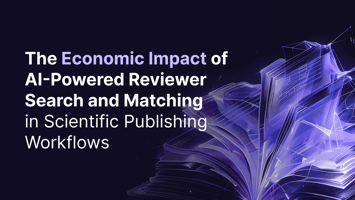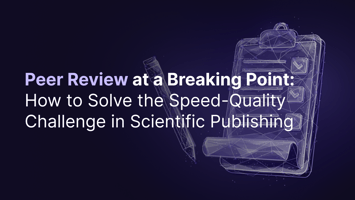When we sit down with scientific publishers and research funding agencies, the conversation...
The Peer Review Crisis: Why Publishers Are Struggling in 2025
Big changes are underway in academic publishing. Intelligent tools are stepping in to tackle the growing challenges in peer review. Recent findings highlight just how serious these issues have become — and how technology could transform the way research is evaluated.
The Most Dramatic Changes Reshaping Peer Review
Three converging trends are creating both significant challenges and remarkable opportunities for academic publishers ready to embrace innovation.
Publication Volume Outpaces Reviewer Capacity
Our analysis of 179 million papers reveals a fundamental mismatch: research output climbs steadily while qualified reviewer pools stagnate. The academic hiring pyramid remains sharp—senior positions that traditionally supply peer reviewers don't expand as rapidly as manuscript submissions across our database of 87 million authors.
Open Access Models Reshape Incentives
Author-paid publishing has transformed business models in ways that inadvertently affect quality. Traditional subscription models required compelling content to attract readers. With upfront author fees, maintaining rigorous editorial selection becomes more complex, enabling predatory publishing practices previously impossible.
Generational Recognition Demands
Today's researchers increasingly expect acknowledgment for peer review contributions, moving beyond decades of anonymous, unpaid service. This shift creates opportunities to build more engaging review ecosystems across our network of 108,000 institutions globally.

How Publishers Are Tackling the Acceptance Rate Crisis
Academic publishers recognize the growing mismatch between review requests and declining acceptance rates, implementing various innovative approaches.
Transparency and Recognition Initiatives
Leading journals now publish reviewer names alongside papers, creating accountability while providing credit. Nature journals recently announced comprehensive open peer review adoption, making entire review conversations publicly available.
Collaborative Review Models
Publishers successfully pair junior researchers with senior collaborators for joint reviews—training new reviewers while leveraging experienced expertise. This addresses both capacity constraints and essential knowledge transfer.
Strategic Editorial Filtering
Desk rejections are increasing as editors protect reviewer pools from exhaustion. While this preserves capacity, it demands sophisticated manuscript screening that goes beyond traditional editorial intuition.
Impact on Publication Workflows and Editorial Quality
Reviewer shortages create cascading effects that extend far beyond simple delays, affecting both manuscript quality and researcher careers.
Timeline Disasters Threaten Careers
We've documented cases where manuscripts take nearly a year from submission to publication. One recent example: submission in September 2024 with publication scheduled for August 2025. For students and early-career researchers depending on timely publication, such delays can derail entire career trajectories.
Quality Compromises From Mismatched Reviews
When publishers struggle to find appropriate reviewers, manuscripts get evaluated by researchers outside their expertise areas, creating two critical problems:
- Important flaws go unnoticed because reviewers lack domain knowledge
- Quality work gets rejected due to reviewer misunderstanding
Our semantic matching technology across 170,000 concepts addresses these issues by ensuring optimal reviewer-manuscript alignment while detecting conflicts of interest automatically.
Where Current Solutions Fall Short
Many publishers still rely on approaches that cannot scale to current demands, creating transformation opportunities.
Legacy Systems Struggle
Publishers continue using Excel spreadsheets and editorial memory for reviewer identification—approaches that worked with manageable volumes but fail at current scale. These systems don't account for researchers shifting expertise or availability changes over time.
Administrative Burden Overwhelms Editors
Traditional manual processes consume enormous editorial time that should focus on manuscript assessment. Our platform automates reviewer searches across 108,000 journals while preserving complete editorial control over selection decisions.
The Future Without Systemic Change
Without technological intervention, current trends could lead to serious consequences for academic publishing integrity and researcher careers.
Publication Becomes "Russian Roulette"
Without addressing these challenges, publication outcomes will become increasingly disconnected from research quality. Manuscript acceptance will depend more on reviewer availability than academic merit, creating a system where quality research faces arbitrary rejection.

System Collapse Risks
Widespread desk rejections will multiply as journals struggle to find reviewers. High-reputation journals might survive longer, but even prestigious publications face mounting strain that threatens scientific communication infrastructure.
Career Destruction
Promising researchers may abandon academia due to publication uncertainty. The human cost extends beyond individual careers—delayed discoveries in medical research could postpone crucial treatments, while stalled climate research might delay essential interventions.
Technology as Collaborative Partner
We're building solutions that preserve human expertise while eliminating administrative bottlenecks that slow publication processes.
Intelligent Automation Enhances Editorial Judgment
Our platform handles time-consuming reviewer identification by analyzing semantic relationships between manuscripts and researcher expertise, allowing editors to focus on manuscript assessment rather than database management.
Scalable Infrastructure Serves All Publishers
From major commercial publishers to specialized society journals, we provide reviewer identification infrastructure that scales with complexity while ensuring smaller publishers access the same advanced editorial tools as large organizations.
Diversity Enhancement Through Systematic Analysis
Advanced filtering options across gender, geography, and seniority help publishers build more inclusive peer review processes while ensuring qualified expertise matching.
Join Us in Reimagining Academic Publishing
The peer review transformation represents opportunity rather than crisis for publishers who embrace intelligent solutions while maintaining scholarly rigor.
We're building this collaborative future where AI amplifies rather than replaces human judgment. Our platform combines semantic analysis, conflict detection, and administrative automation with complete editorial autonomy—creating more efficient, transparent, and inclusive research communication.
Ready to transform your editorial workflow? Discover how intelligent reviewer matching can streamline manuscript review processes while preserving the research integrity your academic community depends on.
Connect with our team to explore how we're helping publishers turn current challenges into competitive advantages.
.png?width=337&height=96&name=Logo%20(1).png)




